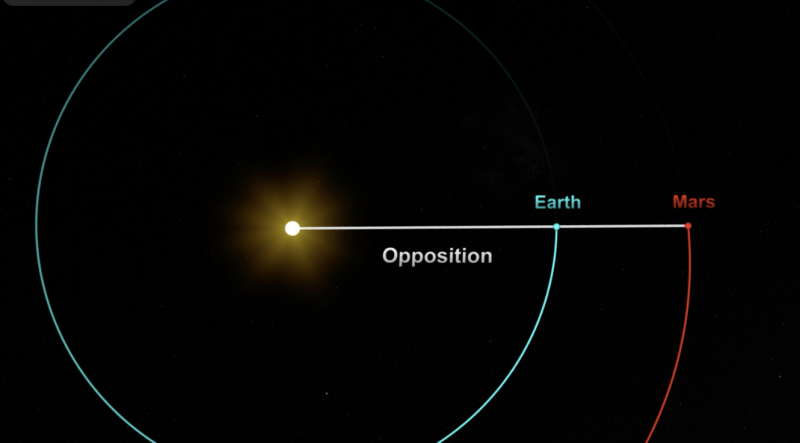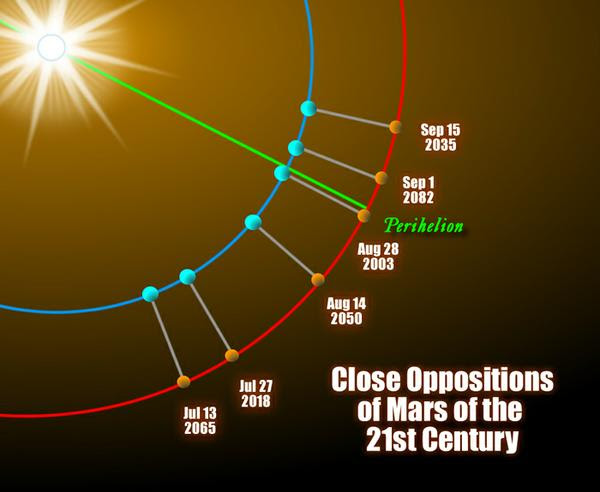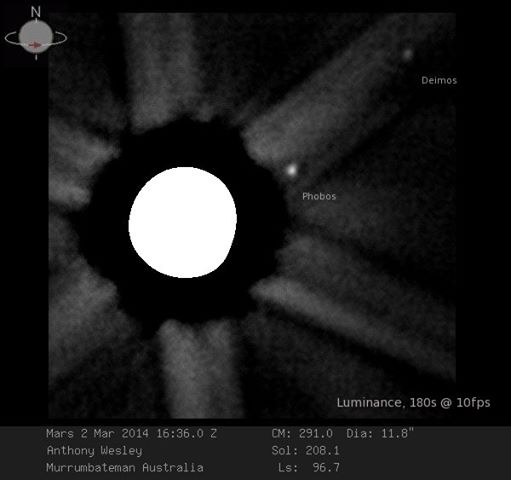
Image at top: When Mars reaches opposition, Earth is between Mars and the sun. Mars and the sun shine on opposite sides of our sky. Visualization via Kel Elkins/ NASA.
On October 13, 2020, Mars comes to opposition in Earth’s sky for the first time since July 27, 2018. In its smaller orbit around the sun, Earth will pass more or less between the sun and Mars at around 23:00 UTC (7 p.m. EDT, 6 p.m. CDT, 5 p.m. MDT and 4 p.m. PDT); translate UTC to your time. When Mars is at opposition, the sun and Mars are on opposite sides of Earth’s sky. Mars rises in the east at sunset, is at its highest at midnight, and sets in the west at sunrise. At this year’s opposition, in particular, Mars will be a fiery red and very wonderful sight all night long. Mars will be brighter at this year’s opposition than it will be again until the year 2035.
Opposition is a special time for any superior planet. Around the time of opposition, as Earth sweeps between the planet and the sun, that planet shines at its brightest in Earth’s sky for that earthly year.
Not all Mars’ oppositions are equal, however. This one is a very good one.

Oppositions of Mars happen about every 26 months. That makes sense because Earth takes a year to orbit the sun, and Mars takes about two years. Every 26 months, we gain a lap on Mars, passing between it and the sun.
Because it’s now closest to us, throughout October 2020 Mars outshines all the stars. It outshines even the king planet Jupiter, which is generally the fourth-brightest sky object after the sun, moon and planet Venus (and Venus is now up before sunrise).
You can’t miss Mars right now!
Extra-close oppositions of Mars (less than 37 million miles or 60 million km) recur in periods of 15 to 17 years. The last extra-close Martian opposition happened on July 27, 2018, and the next one will occur on September 15, 2035. Thus 2020 brings Mars’ brightest appearance in our sky until the opposition of 2035. This October 2020 opposition Mars just misses being extra-close. At opposition this year, Mars is 38.57 million miles (62.07 million km) from Earth.
Extra-close oppositions happen when we go between Mars and the sun around the time Mars is near perihelion, its closest point to the sun. That makes sense, too, right? See the chart below:

An extra-far opposition of Mars – over 62 million miles or 100 million km – last took place on March 3, 2012, when Mars was near aphelion, its farthest point from the sun. As a basis of comparison, the 2018 opposition found Mars some 28 million miles (45 million km) closer than at the extra-far opposition of 2012.
Extra-far oppositions also recur in periods of 15 to 17 years, and the next one will happen on February 19, 2027.
So enjoy Mars this year!

By the way, Mars’ exact closest point to Earth doesn’t typically coincide with the date of opposition. The time interval between opposition and Mars’ nearest point to Earth is no greater than 8.5 days, and can be as little as 10 minutes.
In 2020, we go between Mars and the sun on October 13, but Mars came closest to Earth about a week before, on October 6. Why? It’s because planets in our solar system don’t orbit the sun in perfect circles (although their orbits are very nearly circular). The orbits of both Earth and Mars are ellipses, like circles someone sat down on.
What’s more, the planets in our solar system don’t all orbit the sun on the same plane (although their orbital planes are very similar).
The little differences brought Mars closer to Earth in 2020 on October 6 than on October 13, the day we pass between Mars and the sun.

Bottom line: October 2020 presents Mars at its brightest in our sky until September 2035. Earth passes between Mars and the sun, at opposition, on October 13, 2020, yet Earth and Mars actually came closest together on October 6, 2020.











